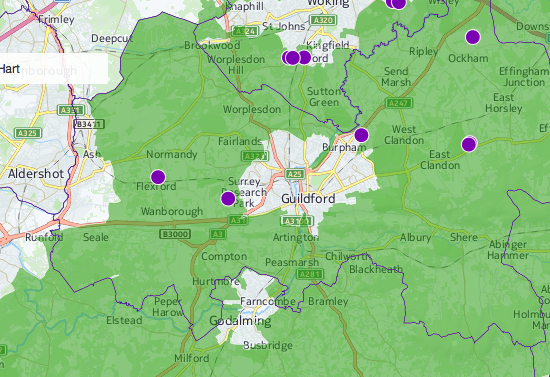 Abraham Lincoln
If given the truth, the people can be depended upon to meet any national crisis...
Abraham Lincoln
If given the truth, the people can be depended upon to meet any national crisis...
 Guildford news...
for Guildford people, brought to you by Guildford reporters - Guildford's own news service
Guildford news...
for Guildford people, brought to you by Guildford reporters - Guildford's own news service
Call for a Review to ‘Soften’ Green Belt Policy Rejected by Most Local Party Leaders
Published on: 20 Sep, 2022
Updated on: 20 Sep, 2022

A CPRE map showing the green belt around Guildford and the designated strategic development sites with the 2019 Local Plan.
By Martin Giles
A call for a review of green belt policy leading to further release of green belt land has been rejected by the leader of the Residents for Guildford and Villages party, who warns: “Planning policies of Westminster already make it far too easy for developers to promote green belt sites.”
The call for a review comes from a planning consultancy Boyer and a property services agency, the Leaders Romans Group.
In a joint press release, the two organisations claim that government figures released on September 16 show that the amount of green belt in England actually increased under new local plans adopted in 2021-22 by 1.5 per cent and now represents 12.6 per cent of all the land in England.
 And in a specific reference to Guildford, the joint statement says: “In Guildford valuable urban brownfield sites have already been utilised, resulting in very high house prices.”
And in a specific reference to Guildford, the joint statement says: “In Guildford valuable urban brownfield sites have already been utilised, resulting in very high house prices.”
Guildford borough lost 1,470 acres of green belt under the 2019 Local Plan. At the time, GBC said this represented only 1.5 per cent of Guildford’s green belt but Local Plan opponents claim the true figure is around six per cent and 46 per cent of all the green belt released in England in 2019/20.
Ian Barnett, National Land Director of the Leaders Romans Group (LRG), while acknowledging the success of green belt policy to date, said it was “little understood by those not in the industry”.
He continued: “…we need a national review of green belt policy. Why should a 70+-year-old policy not be subject to a review? There can’t be much legislation dating from the 1940s that is fit for purpose today. A review of the green belt needs to be undertaken in the context of the needs of the country: transport, environment, housing, leisure, food, and economics. We need a review of the green belt as part of a national spatial plan.
“What do we have instead? We have “levelling up,” he said.
“But February’s Levelling Up White Paper contained just four references to the green belt and the Levelling Up and Regeneration Bill failed to mention it once.
“It is clear that the government views green belt reform as separate from levelling up. This is ironic because the green belt has, to some extent, driven the north-south divide, which itself brought about the need for the levelling up agenda.
“The green belt constrains growth around cities such as Oxford, Cambridge and London, inflating house prices beyond the means of many, especially the young. Arguably, the presence of a green ‘halo’ around these and other locations (notably towns in the South East such as Tunbridge Wells, Sevenoaks, Guildford, Windsor, High Wycombe and St Albans), in which valuable urban brownfield sites have already been utilised, results in very limited opportunities for growth, and therefore a perception of exclusivity.
“Levelling up must be viewed in the context of the bigger picture: the UK as a whole. Unless, through green belt reform, the lack of housing affordability in the South is addressed, the north/south divide will persist and levelling up will remain a distant dream.”
But Cllr Joss Bigmore (R4GV, Christchurch), who is leader of Guildford Borough Council, made his contrary view clear: “I think that the need for the green belt is greater now than at any time in the last 70 years. We need to protect our farmland and countryside for food security and to combat climate change.
“Those that are advocating a review want the green belt diminished in standing and we have to fight that.
“The planning policies of Westminster already make it far too easy for developers to promote green belt sites and change their status. This will only continue at a faster pace unless there are wholesale changes in the government’s planning policies.
“Obviously, construction brings GDP growth, but there are plenty of opportunities in our urban areas to grow far more sustainably. However, urban regeneration is difficult and more expensive which is why developers prefer green fields.”
The leader of the GBC Guildford Greenbelt Group (GGG), Ramsey Nagaty, agreed that the plea for a review was motivated by a desire for more development but thought a review to strengthen protection, in the light of other factors, was appropriate.
He said: “With climate change, the need for UK food security and the increased realisation of the health benefits of the green belt for air quality and personal wellbeing green belt should be given greater protection.
“Without strong resistance by pressure groups such as GGG and CPRE [aka The Countryside Charity] there will be. The housing market needs restructuring as too often buy-to-let landlords and developers outbid those seeking to buy their own home.
“Population in Guildford is not growing: the birth rate is 1.36. Student numbers including the 40 per cent overseas students at Surrey University create an incorrect higher assumption of Guildford’s housing need as recognised by the ONS.
“Green belt policy is meant to ensure brownfield first, something the GBC Local Plan 2019 failed to do. It is critical that inner city regeneration takes place and green belt policy should assist in this. Developers of housing, out-of-town shopping and warehouse development are too keen to look first at green belt and green fields.”
 Karen Charles, director of LRG’s planning and design consultancy, Boyer pointed out: ‘Few would argue for the green belt to be abolished, but its value would be increased if its strictures were softened somewhat.
Karen Charles, director of LRG’s planning and design consultancy, Boyer pointed out: ‘Few would argue for the green belt to be abolished, but its value would be increased if its strictures were softened somewhat.
“Green belt policy and planning policy conflict on many levels and green belt reform is needed to resolve these conflicts, to deliver homes, including affordable homes, up and down the country, and in doing so, to genuinely level up the UK.”
Christian Holliday, a former borough councillor, speaking for the Guildford Conservative Association, said: “The idea that green belt protections have restricted economic growth remains contested, and to change the rules completely would be premature for several reasons:
- the need to restrain urban sprawl and to protect the identity of local communities;
- continuing pressures for overdevelopment in areas of the South East of England;
- the national interest in making a success of the levelling up agenda which could potentially be hindered by a movement in skills from other regions of our country to the South East.
“Green belt policy has been successful in protecting towns and smaller settlements from urban sprawl. It allows communities, particularly those around major cities, to protect their individual character. This has been good for historic towns such as Guildford.
“It is important that, as circumstances change and towns like Guildford grow, any adjustment to green belt boundaries is made with full consideration of the need to balance the protection of our vital landscapes and openness with future housing requirements.
“Any decision to release land from the green belt should be decided at a local level, within the context of a Local Plan review, taking into consideration important local contexts such as the availability of brownfield land.”
Brian Creese, chair of the Labour Party in Guildford, pointed out his party’s role in creating the green belt. “However,” he said, “Labour is also realistic.
“The green belt was established when the population was considerably smaller than it is today, and we recognise the terrible impact the current housing crisis is having on young people around the country and particularly in the South East in places like Guildford.
“This is why sensible planning is important to draw the right line between maintaining important green spaces while developing smaller, genuinely affordable, medium-sized housing for young families. We are more concerned with building appropriate, high-quality, well-designed housing than regarding the green belt as sacrosanct.
“Our villages are important and wonderful places to live. Few villages want – or can – absorb huge new developments, but most villages should be able to build a few units, particularly if designated for local families.
“It probably is time to review green belt policy and how green areas are developed; town dwellers need a bigger share of the green space: the pandemic showed that. Guildford’s big problem seems to us to be the council’s lack of vision for the town and piecemeal planning. It can’t even get the brownfield sites off the blocks.”
The Liberal Democrats were also invited to comment.
Responses to Call for a Review to ‘Soften’ Green Belt Policy Rejected by Most Local Party Leaders
Leave a Comment Cancel replyPlease see our comments policy. All comments are moderated and may take time to appear.
Recent Articles
- Guildford Institute’s Crowdfunding Project for Accessible Toilet in its New Community and Wellbeing Centre
- Letter: Guildford – Another Opportunity Missed?
- Letter: GBC’s Corporate Strategy – Where Is the Ambition?
- My Memories of John Mayall at a Ground-breaking Gig in Guildford Nearly Six Decades Ago
- Westborough HMO Plans ‘Losing the Heart of the Street’ Says Resident
- College Invests to Boost Surrey’s Economy and Close Digital Skills Gap
- Community Lottery Brings Big Wins for Local Charities
- GBC Housing Plan Promises ‘A Vibrant Urban Neighbourhood’ Near Town Centre
- Hospital Pillows ‘Shortage’ at the Royal Surrey
- Updated: Caravans Set Up Camp at Ash Manor School


Recent Comments
- Ian Macpherson on Updated: Main Guildford to Godalming Road Closed Until August 1
- Sara Tokunaga on GBC Housing Plan Promises ‘A Vibrant Urban Neighbourhood’ Near Town Centre
- Michael Courtnage on Daily Mail Online Reports Guildford Has Highest-paid Council Officer
- Alan Judge on GBC Housing Plan Promises ‘A Vibrant Urban Neighbourhood’ Near Town Centre
- John Perkins on GBC Housing Plan Promises ‘A Vibrant Urban Neighbourhood’ Near Town Centre
- S Collins on GBC Housing Plan Promises ‘A Vibrant Urban Neighbourhood’ Near Town Centre
Search in Site
Media Gallery
Dragon Interview: Local Artist Leaves Her Mark At One of England’s Most Historic Buildings
January 21, 2023 / No Comment / Read MoreDragon Interview: Lib Dem Planning Chair: ‘Current Policy Doesn’t Work for Local People’
January 19, 2023 / No Comment / Read MoreA3 Tunnel in Guildford ‘Necessary’ for New Homes, Says Guildford’s MP
January 10, 2023 / No Comment / Read More‘Madness’ for London Road Scheme to Go Ahead Against ‘Huge Opposition’, Says SCC Leader
January 6, 2023 / No Comment / Read MoreCouncillor’s Son Starts Campaign for More Consultation on North Street Plan
December 30, 2022 / No Comment / Read MoreCounty Council Climbs Down Over London Road Works – Further ‘Engagement’ Period Announced
December 14, 2022 / No Comment / Read MoreDragon Interview: GBC Reaction to the Government’s Expected Decision to Relax Housing Targets
December 7, 2022 / No Comment / Read MoreHow Can Our Town Centre Businesses Recover? Watch the Shop Front Debate
May 18, 2020 / No Comment / Read More













Daniel Hill
September 20, 2022 at 2:34 pm
This statement from a planning consultancy and a property services agency is all about greed. There are plenty of brownfield sites in Guildford. Developers want our green fields because they are cheaper and easier.
If we want to protect the green belt GBC needs a robust brownfield first planning policy.
Alan Robertson
September 21, 2022 at 1:46 pm
It was because of influence of unscrupulous, greedy, developers and the decisions of councillors, more than happy to be influenced, that the destructive Local Plan was passed.
Jim Allen
September 22, 2022 at 10:40 am
The existence of green belt does need revisiting. The benefits highlighted by all commentators are correct but, I would say yes let’s revisit the green belt policy and enlarge them to include:
All local green spaces (including those specified in Neighbourhood Plans);
“Animal tracks”, natural routes of native vegetation to encourage safe routes for animals to track across urban areas safely (eg old railway lines);
Widen protection zones on water courses to 30 metres, not 10metres as currently required by the Environment Agency;
Double the safe area around mature trees from “single root reach” to double root reach.
Surely developers would want to be able to say “look how we are saving the environment in our development sites”, wouldn’t they?
So yes, revisit the policy but upgrade to greater protect out green areas.